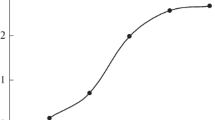Summary
A simple, rapid, selective, and sensitive method for the spectrophotometric determination of palladium is developed based on the reaction of Pd(II) with 1-amino-4-hydroxyanthraquinone (AMHA). The reaction is carried out atpH 3.8 in 50% (v/v) ethanol-water medium. The molar absorptivity of the complexed ligand is 1.1 · 104 l mol−1 cm−1 at 620 nm. Calibration plots are linear up to 17 µg Pd cm−3. The optimum concentration range (Ringbom plot) is between 3–14.5 µg cm−3. The spectral study of the reaction in solutions containing equimolar concentrations or an excess of one component, in thepH range ∼ 0.3–6.5, indicate the possible complex transitions that occur in solution. Complete graphical and logarithmic analysis of the absorbance-pH graphs was performed to demonstrate and characterize the complexation equilibria in solution. Under the optimum conditions, palladium can be determined as the noncharged complex Pd(AMHA)2 in the presence of a large number of foreign ions. Interferences caused by zirconium(IV) could be masked with fluoride ions.
Zusammenfassung
Eine einfache, schnelle und empfindliche Methode für die spektrophotometrische Bestimmung von Palladium wurde auf der Basis der Reaktion von Pd(II) mit 1-Amino-4-hydroxyanthrachinon (AMHA) entwickelt. Die Reaktion wird in 50% (v/v) Ethanol/Wasser beipH 3.8 ausgeführt. Die molare Absorption des komplexierten Liganden beträgt 1.1 · 104 l mol−1 cm−1 bei 620 nm. Kalibrierungskurven verlaufen bis zu 17 µg Pd cm−3 linear. Der optimale Konzentrationsbereich (Ringbom-Plot) liegt zwischen 3 und 14.5 µg cm−3. Spektroskopische Untersuchungen der Reaktion in Lösungen, entweder mit equimolaren Konzentrationen oder mit einem Überschuß an einer Komponente impH-Bereich ∼ 0.3–6.5, lassen Rückschlüsse auf mögliche Komplex-Übergänge in Lösung zu. Es wurde eine vollständige graphische, logarithmische Analyse der Absorptions-pH-Graphen durchgeführt, um die Komplexgleichgewichte in Lösung aufzuklären und zu charakterisieren. Unter den Optimalbedingungen kann Palladium als nichtgeladener Komplex Pd(AMHA)2 in Gegenwart einer großen Anzahl an Fremd-Ionen bestimmt werden. Schwierigkeiten mit Zirkonium(IV) konnte durch Maskierung mit Fluorid-Ionen umgangen werden.
Similar content being viewed by others
References
Idriss K. A., Hassan M. K., Abu-Bakr M. S., Sedaira H. (1984) Analyst109: 1389
Idriss K. A., Seleim M., Hassan M. K., Abu-Bakr M. S., Sedeira H. (1985) Analyst110: 705
Seleim M. M., Idriss K. A., Saleh M. S., Hashem E. Y. (1986) Analyst111: 677
Seleim M. M., Idriss K. A., Saleh M. S., Hashem E. Y. (1986) Polyhedron5 (10): 1525
Seleim M. M., Idriss K. A., Abu-Bakr M. S., Hassan M. K., Saleh M. S. (1988) Ann. Chim.781: 207
Seleim M. M., Idriss K. A., Abu-Bakr M. S., Saleh M. S. (1988) Anales de QuimicaB 84: 168
Idriss K. A., Seleim M. M., Saleh M. S., Abu-Bakr M. S., Sedaira H. (1988) Analyst113: 1643
Kuban V., Havel J. (1973) Acta Chem. Scand.27: 528
Vogel A. I. (1978) Textbook of Quantitative Inorganic Analysis, 4th edn. EIBS, London
Douheret G. (1967) Bull. Soc. Chim. Fr.: 1412
Sommer L., Kuban V., Havel J. (1970) Folia Fac. Sci. Nat. Univ., Brno, Chemia7: part 1
P. Job (1928) Ann. Chem.9: 113
Singh A. K., Katyal M., Bhatti A. M., Ralhan N. K. (1976) Talanta23: 337
Gowda S. H., Thimmaiah K. N. (1976) Fresenius' Z. Anal. Chem.279: 208
Gowda S. H., Keshavan B. (1976) J. Ind. Chem. Soc.53: 688
Mahgoub A. E., Darwish N. A., Soukry M. M. (1978) Analyst103: 879
Kothny E. L. (1978) Mikrochim. Acta [Wien]I: 425
Sanchez-Pedreno C., Gonzalez Diaz V., Polo Conde F. (1978) An. Quim.74: 1502
Desai B. J., Shinde V. M. (1979) Fresenius' Z. Anal. Chem.295: 412
Khasnis D. V., Shinde V. M. (1979) Talanta26: 593
Napdi A. (1979) Ann. Chim. (Rome)69: 339
Elsirafy A. A. (1980) Analyst105: 912
Gowda S. H., Padmaji K. A., Thimmaiah K. N. (1981) Analyst106: 198
Morelli B. (1984) analyst109: 47
Yun Po C., Nan Z. (1986) Talanta33 (12): 939
Author information
Authors and Affiliations
Rights and permissions
About this article
Cite this article
Idriss, K.A., Saleh, M.S., Seleim, M.M. et al. New spectrophotometric method for the determination of trace amounts of palladium. Monatsh Chem 121, 625–634 (1990). https://doi.org/10.1007/BF00809765
Received:
Revised:
Accepted:
Issue Date:
DOI: https://doi.org/10.1007/BF00809765



